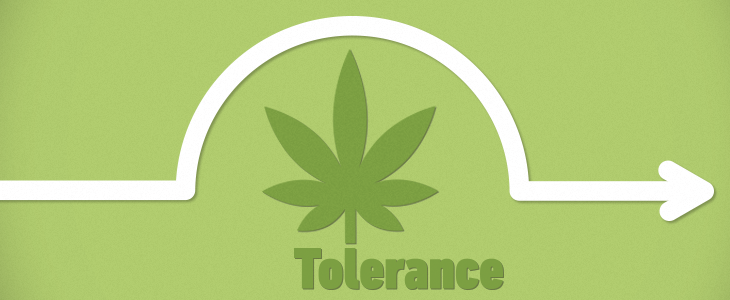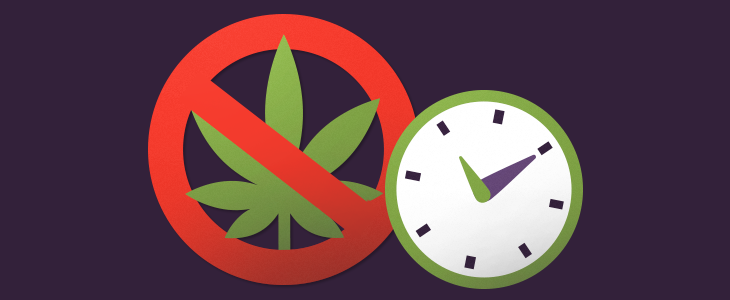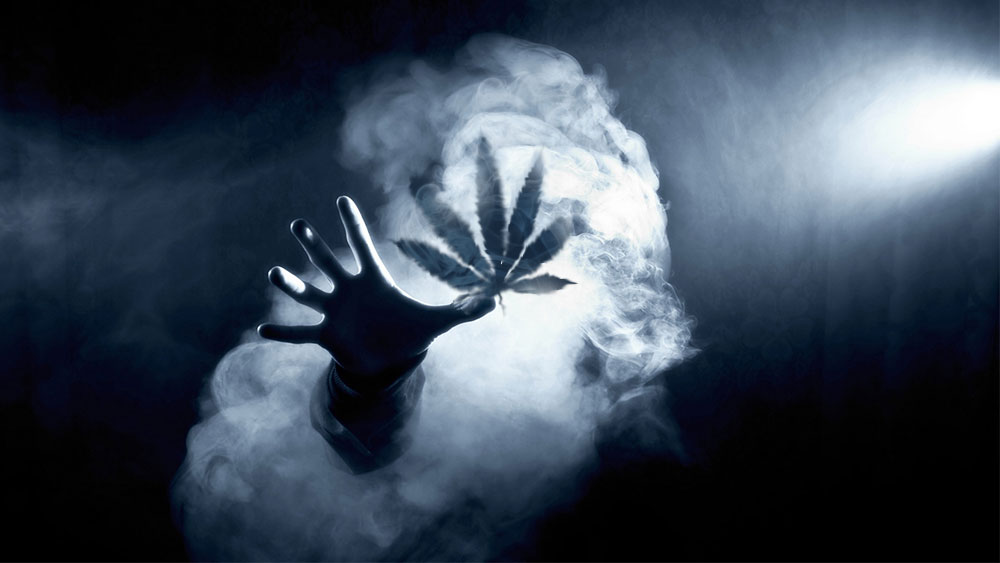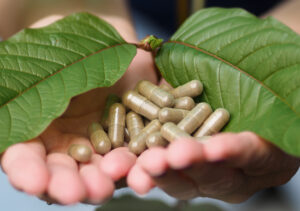The majority of experienced cannabis users develop marijuana tolerance at some point.
Novice and occasional users don’t need a lot of weed to get high initially.
As they start using cannabis more frequently, they quickly notice how their tolerance rises and, suddenly, they need more to achieve the same effects.
In this article, we’ll explore what exactly causes marijuana tolerance, how to overcome it, and how to effectively take a tolerance break.
What is Marijuana Tolerance?

Marijuana tolerance is the brain’s adaptation to the constant presence of cannabinoids, causing a user to need higher doses of marijuana to obtain the effect of the first dose.
Developing tolerance means that after some time of consuming cannabis you become a bit resistant to it and need increasingly larger amounts to get high.
Tolerance builds up with many substances, not just with cannabis. Caffeine is one of them.
Tolerance happens because of a neurological phenomenon called downregulation.
As you expose your system to one substance, the number of receptors in the brain that react to that particular substance reduces over time because your body strives to maintain balance and prevent overload.
As soon as this process starts, you need more of that substance to achieve the same effects.
THC, a psychoactive compound in cannabis and one of the most abundant cannabinoids, produces effects by attaching itself to two groups of cellular receptors, CB1 and CB2.
Therefore, the downregulation of CB1 and CB2 (cannabinoid receptors type 1 and 2) leads to developing cannabis tolerance.
One recent study confirmed that marijuana tolerance is real. The group of researchers did an experiment with male participants aged between 18 and 35. The study focused on CB1 receptors, for which THC has a considerable binding affinity.
Besides proving what we’ve already suspected, they also found something very interesting: regular (but moderate) daily cannabis users had 20% less CB1 receptors than the participants from the control group who did not use cannabis. (1)
And how long does it take to regenerate CB1 receptors?
Well, believe it or not, it takes just two days to four weeks of abstinence to regenerate almost all of your CB receptors.
What was really surprising in this study is that no matter how much cannabis they consumed, after just a two-day tolerance break, test subjects started growing their CB1 receptors back. (1)
This study was criticized for not including female participants since THC supposedly affects women differently, but we can all agree that this is a good starting point for further research.
Besides sex, there are many other factors that affect how people build up the tolerance to cannabis.
Both the consumption method and the amount consumed play a major role in developing tolerance, as do some physiological factors like the body mass index, for example.
The truth is that the human body can become tolerant of cannabis very quickly.
It takes just one week of frequent cannabis use to build enough tolerance to start needing an increased amount for the same effects. The situation gets even worse when you realize that using high THC products leads to developing tolerance faster. (2)
Interestingly enough, it seems that CB receptors in certain parts of the human body downregulate faster than others. Colon, for example, seems to be resistant to cannabis tolerance. (3)
How to Avoid Developing Cannabis Tolerance?

There are a few things that you can do to avoid building up weed tolerance.
First off, know that this primarily happens with heavy daily consumers.
So, the first thing you can do is to reduce the frequency and volume of cannabis consumption to a moderate level.
The trick is to use an approach called microdosing, which relies on using the smallest amounts of cannabis you need to achieve the desired effects. This approach is particularly useful for medical users who need to stay medicated throughout the day.
To do this properly, take just a few puffs at a time. By following this routine you will not be completely resistant to developing tolerance, but you will not build it up as quickly as if you were to smoke an ounce a day all by yourself.
We interviewed Dr. Dustin Sulak who treated over 18,000 patients with medical cannabis and put his microdosing strategies in a free eBook. Download the blueprint to the most effective cannabis dosage regimen.
When to Take a Marijuana Tolerance Break?
When you reach the point where almost no amount of cannabis can get you high enough, it’s time to take a break and rebuild your receptors.
The easiest way to do so is to abstain from cannabis for 1-2 weeks.
The more you abstain, the better your results will be, but a week should be the absolute minimum.
Taking a weed tolerance break is actually not that difficult, as you’ll be motivated by the fact that your receptors will recover fully. Best of all, the first joint you light up after that week will feel like you’re getting high for the first time.
Although it can be tough to stay away from weed, especially when the anxiety kicks in, give it your best and try to stay on the right path. Trust me, it’s worth it.
Here are a few tricks that I use when I’m taking tolerance breaks.
First, schedule your day ahead. Keep yourself busy, stay active, and try to work out. Go back to some of your old hobbies (if you had them) and try to eat healthier.
Put away all your smoking gear. Pipes, bongs and rolling papers should be out of your sight during the break.
Get rid of your weed.
No, really—don’t stash it for when the break is over. It’s always tempting when you know you have some in the bottom drawer.
Surround yourself with people you love, attend social events. All in all, do the things that really make you happy (except smoking weed, yikes).
How to Lower Marijuana Tolerance without Taking a Break?

For medical users who need cannabis just to get through the day, taking a tolerance break is not possible.
Anxiety, sleepless nights, and mood changes are just a few side effects of taking a weed tolerance break.
However, there are a few methods to lower your tolerance to some extent without quitting weed completely.
Change Your Routine
Although we humans are addicted to routines, switching it all up from time to time can be very beneficial. And I suppose you already have a routine when it comes to smoking weed.
However, your body will eventually get used to all those cannabinoids at the same exact time and that will aid in boosting your tolerance up.
By introducing a few changes in your daily routine, you’re shocking your body and you’re not letting it get used to cannabis.
To start, try consuming weed at different times than usual. That can actually trick your brain into thinking you are doing something new.
Don’t Wake and Bake
When you get stoned in the morning, you have to smoke all day to maintain the same level of high. And that’s not good if you are trying to lower your tolerance. So, we go back to the first advice: try smoking later in the evening to shock your body a little bit.
Limit the Amount of Cannabis You Consume
It’s simple. More weed leads to developing tolerance faster. So, if you’ve already reached a point where you need more and more to get high, you might want to go down the opposite route and start smoking less. I talked about microdosing earlier in this article, but if that doesn’t do the trick for you, cut the amount of weed you smoke by half.
Also, try cutting down the number of daily smoke sessions.
Use Smaller Rolling Papers
Smaller papers, smaller joints, less weed. This is a good starting point and the easiest way to cut the amount of weed you are smoking without having to quit completely.
King size joints build up your tolerance quickly, so switch to smaller ones.
Change Your Method of Consumption
Besides smoking, you can vape or make edibles. Dabbing will definitely knock you out of your shoes since the concentrates are much more potent than regular flowers.
Edibles are a great alternative to smoking if you’re looking to switch this up as well. In fact, eating a brownie infused with cannabutter can actually get you really high.
Smoking gets cannabinoids into your body in just a few minutes, but the effects don’t last as long as with edibles.
Since the digestion process takes much more time, it will take about 45 minutes to feel the effects of weed. But once THC starts to kick in, the high is much stronger — and lasts for hours.
Try a Different Strain
There are thousands of strains out there, with different THC to CBD ratios and different terpene profiles. Try something new and different. Check out strains with different potencies and explore what your budtender has to offer you.
Find the right strain for you
Whether you want to relieve anxiety, pain or depression, the right strain is out there. Use our online tool to narrow the search.
Get StartedSwitch to High CBD Strains for a While
If you are working on lowering your marijuana tolerance, maybe it’s time to try some CBD strains. Since CBD diminishes the psychoactive effects of THC, you will not feel that buzz in your head as you normally would.
Take Supplements
If you are a medical user, taking a tolerance break might be a no-go, but keep in mind that there are other natural remedies and supplements.
Even though cannabis might be a natural remedy for many conditions, there are other plant-based alternatives that can get you through your tolerance break.
Valerian root is a mild natural remedy for insomnia and anxiety. Lavender oil capsules also reduce anxiety and help you take the edge off and get through the day.
Omega-3 fatty acids help the endocannabinoid system function properly. According to a study conducted by the Neurocentre Magendie in Bordeaux, France, a lack of dietary Omega-3 fatty acids leads to an inhibited function of the CB1 receptors, which may result in mood swings and impaired emotional behavior. (4)
To put this into perspective, if you don’t consume enough Omega-3’s, you get poor-performing CB1 receptors and the entire functioning of your endocannabinoid system is in jeopardy. This means you automatically need more weed to get high.
Stock up on Omega 3’s by eating fish, nuts, and seeds (like chia seeds). Alternatively, you can always supplement with Omega-3’s, but just make sure you find a reputable brand.
Summary
- Marijuana tolerance is very common among stoners and largely depends on the frequency and volume of use.
- Tolerance develops when you over-sensitize CB receptors from excess THC, which then reduce in numbers.
- If you start noticing that you need increasingly more weed to get high, it’s time to take a tolerance break.
- To regenerate your receptors back and rebuild your tolerance, abstain from weed for 1-4 weeks.
References
- D’Souza DC, Cortes-Briones JA, Ranganathan M, Thurnauer H, Creatura G, Surti T, Planeta B, Neumeister A, Pittman B, Normandin M, Kapinos M, Ropchan J, Huang Y, Carson RE, Skosnik PD; Rapid Changes in CB1 Receptor Availability in Cannabis Dependent Males after Abstinence from Cannabis; Biological Psychiatry. Cognitive Neuroscience and Neuroimaging; January 2016; 1(1):60-67
- Maldonado R; Study of cannabinoid dependence in animals; Pharmacology and Therapeutics; August 2002; 95(2):153-64
- Sim-Selley LJ; Regulation of cannabinoid CB1 receptors in the central nervous system by chronic cannabinoids; Critical Review in Neurobiology; 2003;15(2):91-119
- Lafourcade M, Larrieu T, Mato S, Duffaud A, Sepers M, Matias I, De Smedt-Peyrusse V, Labrousse VF, Bretillon L, Matute C, Rodríguez-Puertas R, Layé S, Manzoni OJ; Nutritional omega-3 deficiency abolishes endocannabinoid-mediated neuronal functions; Nature Neuroscience; March 2011; 14(3):345-50









kevin joseph November 27, 2018 at 8:48 am
Marijuana tolerance is the human brain’s version to the steady presence of cannabinoids, in which higher doses of marijuana are had to acquire the impact of the primary dose. Tolerance in any respect ranges of complexity in the brain involves "studying" within the experience of the acquisition of compensatory variations to the effects of the presence of a drug-produced disturbance in function.
guy January 15, 2019 at 6:57 pm
Nice article .. thanks! I'm vaping nightly in the beautiful nature at the moment .. usually about 0.1 gram per night session and with mild Dutch weed. But I've found that to optimise the 'first time' magic feeling .. vaping one night in three works a treat and leaves two nights in three free for socialising.
Mark September 17, 2019 at 4:48 pm
This article was very helpful. However, I feel that the idea that you can't take a break without getting rid of your cannabis is dead wrong. As a lifetime chronic pain sufferer I can tell you that drug insecurity is a far greater hazard than temptation. If one is completely unable to resist cannabis, one should probably think about a lifestyle change. I depend on cannabis to help me lead a more normal life. This elevation of importance has forced me to be disciplined. Anyone can develop self discipline and it's free!
Bill October 12, 2019 at 6:13 pm
I'm a new user. I'm currently smoking joints a few times per day. Usually 2-3 puffs gets me high. It's been about 10 days since I've started but I still wonder one thing. I read the article about tolerance and I get that but I don't particularly like the feeling I have when I'm high.I don't feel I could carry-on a meaningful conversation with anyone and I kind of just want to lie down for awhile. Will this feeling change over time, as my tolerance grows? TIA
Jarles October 22, 2019 at 5:28 pm
Yes. However, I find that consumption of thc is more enjoyable in an isolated setting anyways (naps, movies, games, books). I can't think properly when I'm stoned, therefore I struggle in social settings. If you don't like the feeling, why do it? One more thing, vaporizing CO2 hash oil produces a much "cleaner" high.
Billy April 6, 2020 at 11:25 am
Yes most definitely will
Fred June 3, 2020 at 5:58 pm
When I was starting out, I felt the same way. Part of this can be who you’re spending time with. It really has to be someone you trust and feel comfortable around. Let them know what’s going on, and you might be surprised about how much better you feel. Another thing I found helpful early on was to consciously map out the time. This helps to stay consciously on top of the high. Like, if I’m really feeling and disliking the effects, I look at the clock and keep track of how long the bad feeling lasts. This can help put you in the driver’s seat, so to speak. Also, find something to delve into (music can be great for this). Pick a song or composition (or film, or piece of art) that you know and love, then ‘re-experience’ it from this new perspective. This can help bring out the positive, rather than disorienting aspects of the drug. It really (I’m sure you know by now) is a highly subjective experience, and one that I have found I have a fair degree of control over when I’m intentional about it. Hope that helps. Though since you posted last October, you’ve probably found your own way.